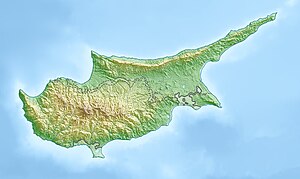Kataliontas
Kαταλιόντας | |
|---|---|
village | |
 | |
| Coordinates: 34°59′29″N 33°17′56″E / 34.99139°N 33.29889°E | |
| Country | |
| District | Nicosia District |
| Population | |
| • Total | 0 |
| Time zone | UTC+2 (EET) |
| • Summer (DST) | UTC+3 (EEST) |
Kataliontas (Greek: Καταλιόντας) was a small village in the Nicosia District of Cyprus, 2 km south of Analiontas.
Habitation in the area of Kataliontas can be traced back to the Neolithic era.[1] The government of Analiontas has attributed both its own name and the name of Kataliontas, respectively meaning "upper lion" and "lower lion" in Greek, to the age of Venetian Cyprus, but maps from the time labeled Kataliontas as Katolido.[2]
Kataliontas had an estimated population of 14 in 1921, all Turkish Cypriots, but in later censuses as counted together with Analiontas. Kataliontas was abandoned in 1958 during the Cypriot intercommunal violence. The remains of the village were demolished in 1977.[2]
References
[edit]- ^ Beck, Julien (2011). "L'occupation néolithique de Kataliondas-Kourvellos : état de la question". Cahiers du Centre d'Etudes Chypriotes. 41 (1): 79–84. doi:10.3406/cchyp.2011.1099.
- ^ a b "KATALIONTAS". www.prio-cyprus-displacement.net.


Well, that’s interesting to know that Psilotum nudum are known as whisk ferns. Psilotum nudum is the commoner species of the two. While the P. flaccidum is a rare species and is found in the tropical islands. Both the species are usually epiphytic in habit and grow upon tree ferns. These species may also be terrestrial and grow in humus or in the crevices of the rocks.
View the detailed Guide of Psilotum nudum: Detailed Study Of Psilotum Nudum (Whisk Fern), Classification, Anatomy, Reproduction